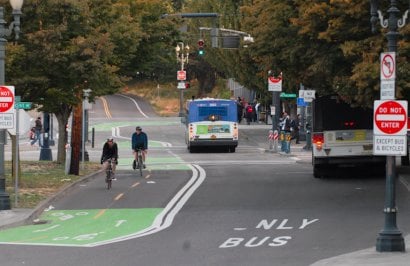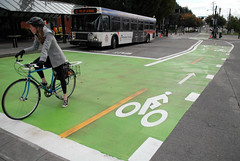
(Photos © J. Maus)
It’s been just about one year since the City of Portland’s Bureau of Transportation (PBOT) laid down a new bikeway and opened the Rose Quarter Transit Center to bicycle access. Since then, there have been no high-profile collisions or rash of complaints, but TriMet operators say the area remains one of the most stressful in the system.
“In some ways it’s better, but in other ways you see things there that just take your breath away. One [train] operator calls it ‘The Death Pit'”.
— Dan Christensen, TriMet bus operator
The effort was years in the making and it required a collaborative approach between PBOT, TriMet, and the Bicycle Transportation Alliance (BTA). Previously, bicycles were prohibited from riding on NE Occident Ave (which is the direct route through the transit center between N Interstate and N Williams).
When plans surfaced to allow bicycles access to this area — which is a very busy corridor for TriMet buses and light rail trains — a group of TriMet employees sent a strongly worded letter and petition to local media outlets in opposition to the idea.
They said the bike access plans would “cost lives” and that there would be “fatal results” if they didn’t speak out and prevent the plans from moving forward.
Eventually, the plans moved forward. A new bikeway and signage were installed and opened for business on October 16th, 2008 (a day after PBOT, TriMet, the BTA and the Mayor’s office held a press conference and parade to mark the occasion).
Since then, TriMet and PBOT say the plans have worked out swimmingly.
TriMet planner Colin Maher says from what he’s seen and heard, everything has going according to plan. “Everyone has adjusted well to the changes.”
Maher told us that TriMet and PBOT took feedback from operators and other users to fine-tune the design. One example he gave was that they adjusted the traffic signals to give both buses and bikes time to make it through the intersections.
Maher also said that he’s not aware of any complaints or collisions.
PBOT bicycle coordinator Roger Geller echoes those sentiments, saying that it’s “good news” he hasn’t received any complaints. Geller also notes that the green thermoplastic has held up well, and, in his “anecdotal observation” most cyclists have been complying with the signal.
Southeast Portland resident Mike Tewfik works at Emanuel Hospital and rides through the Rose Quarter Transit Center every day. He says his commute has gotten “a lot better” since the bikeway improvements were made. Tewfik adds that one problem he’s noticed are people that walk through red lights “without looking” on their way to catch a transfer. “This morning in fact a man walked right in front of a bus and myself listening to his iPod and not even turning his head.”
Almost every rider I’ve heard from in preparing this story said they appreciate how the bikeway has made the area much more “predictable”. One of them acknowledged that it’s “A slightly chaotic space” but because it’s now well-marked, he’s never had a close call or “unpleasant confrontation”.
Bus operator Dan Christensen says despite the new bikeway markings, signage, and other changes to facilitate bike traffic, he finds that driving through the Rose Quarter is “a very stressful situation”.
Christensen is appreciative of the efforts to make the bike traffic predictable, but says he’s still concerned. “In some ways it’s better, but in other ways you see things there that just take your breath away. One [train] operator calls it ‘The Death Pit'”.
While PBOT and TriMet report no official collision numbers, Christensen says what they never track are “emergency stops”. He says he’s had about five instances where he’s had to make very sudden stops to avoid hitting a person on a bicycle. Christensen says people using the new bike traffic lanes aren’t what cause him the most stress. He’s more concerned with people riding outside the designated areas. “A lot of bikers still go around it… it’s not even as heavily used as I thought it would be.”
Christensen also points out that while bike riders won big in the plans, people with disabilities got the short end of the stick (in order to decrease bus/bike interactions, TriMet moved several bus stops further away from the light rail station). “When I have to let people out on a walker or a wheelchair and have them go a block uphill to get their connection, it’s hard to say ‘hey, those new bike lanes are great aren’t they!'”.
But TriMet’s Maher says the stop relocations and resulting longer transfer distances are an “unexpected benefit” of the project. “[With the relocated bus stops] pedestrian traffic was channeled to crosswalks, making these crossings safer.”
While some stressful interaction remain, on the whole it seems like this project has been a success. The design works likely due to the collaborative approach that included TriMet (planners and operators), advocates, and city engineers.




